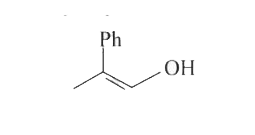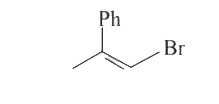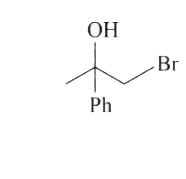1-methyl-1-phenyl ethylene oxide when treated with HBr produce




The correct Answer is:B
To solve the problem of what 1-methyl-1-phenyl ethylene oxide produces when treated with HBr, we can follow these steps:
Step 1: Identify the Structure
1. Draw the structure of 1-methyl-1-phenyl ethylene oxide.
- Ethylene oxide is a cyclic ether (an epoxide) with the formula C2H4O.
- The compound has a methyl (–CH3) and a phenyl (–C6H5) group attached to the first carbon of the ethylene oxide.
- The structure can be represented as follows:
OCH3C6H5
Step 2: Reaction with HBr
2. Understand the reaction mechanism with HBr.
- When 1-methyl-1-phenyl ethylene oxide reacts with HBr, the oxygen atom in the epoxide ring has a lone pair that can attack the hydrogen (H+) from HBr.
- This leads to the formation of a protonated epoxide, where the oxygen becomes positively charged (O+).
Step 3: Formation of Carbocations
3. Determine the possible carbocations formed.
- The protonation of the oxygen leads to a transition state where the epoxide ring can open.
- There are two possible sites for the ring to open:
- If the bond between the oxygen and the carbon attached to the phenyl group breaks, it leads to a tertiary carbocation.
- If the bond between the oxygen and the carbon attached to the methyl group breaks, it leads to a primary carbocation.
- The tertiary carbocation is more stable due to hyperconjugation and resonance stabilization from the phenyl group.
Step 4: Nucleophilic Attack
4. Nucleophilic attack by bromide (Br-).
- The bromide ion (Br-) present in the solution will attack the more stable carbocation (the one formed from the phenyl group).
- This results in the formation of the final product.
Step 5: Final Product Structure
5. Draw the final product.
- The final product will have a bromine atom (Br) attached to the carbon that was part of the carbocation, and the hydroxyl group (OH) will be on the other carbon.
- The structure of the final product can be represented as:
OHCH3C6H5Br
Conclusion
The major product formed when 1-methyl-1-phenyl ethylene oxide is treated with HBr is a compound containing a bromine atom, a hydroxyl group, a methyl group, and a phenyl group.
1. Draw the structure of 1-methyl-1-phenyl ethylene oxide.
- Ethylene oxide is a cyclic ether (an epoxide) with the formula C2H4O.
- The compound has a methyl (–CH3) and a phenyl (–C6H5) group attached to the first carbon of the ethylene oxide.
- The structure can be represented as follows:
OCH3C6H5
2. Understand the reaction mechanism with HBr.
- When 1-methyl-1-phenyl ethylene oxide reacts with HBr, the oxygen atom in the epoxide ring has a lone pair that can attack the hydrogen (H+) from HBr.
- This leads to the formation of a protonated epoxide, where the oxygen becomes positively charged (O+).
3. Determine the possible carbocations formed.
- The protonation of the oxygen leads to a transition state where the epoxide ring can open.
- There are two possible sites for the ring to open:
- If the bond between the oxygen and the carbon attached to the phenyl group breaks, it leads to a tertiary carbocation.
- If the bond between the oxygen and the carbon attached to the methyl group breaks, it leads to a primary carbocation.
- The tertiary carbocation is more stable due to hyperconjugation and resonance stabilization from the phenyl group.
4. Nucleophilic attack by bromide (Br-).
- The bromide ion (Br-) present in the solution will attack the more stable carbocation (the one formed from the phenyl group).
- This results in the formation of the final product.
5. Draw the final product.
- The final product will have a bromine atom (Br) attached to the carbon that was part of the carbocation, and the hydroxyl group (OH) will be on the other carbon.
- The structure of the final product can be represented as:
OHCH3C6H5Br
The major product formed when 1-methyl-1-phenyl ethylene oxide is treated with HBr is a compound containing a bromine atom, a hydroxyl group, a methyl group, and a phenyl group.
Topper's Solved these Questions
- BOOK - VMC MODULES ENGLISHCHAPTER - JEE MAIN REVISION TEST- 24 EXERCISE - CHEMISTRY (SECTION - 2)5videos
JEE MAIN REVISION TEST- 24
- BOOK - VMC MODULES ENGLISHCHAPTER - JEE MAIN REVISION TEST- 16EXERCISE - CHEMISTRY (SECTION 2)5videos
JEE MAIN REVISION TEST- 16
- BOOK - VMC MODULES ENGLISHCHAPTER - JEE Main Revision Test-20 | JEE-2020 EXERCISE - CHEMISTRY25videos
JEE Main Revision Test-20 | JEE-2020
Similar Questions
Styrene when treated with HBr produces :
View SolutionThe ether
 when treated with HI produces View Solution
when treated with HI produces View SolutionThe ether
 when treated with HI produces:View Solution
when treated with HI produces:View Solution1, 1-dimethyl ethylene oxide when treated with water in presence of acid catalyst produces –
View SolutionEthylene oxide when treated with Grignard reagent yields
View SolutionEthylene oxide when treated with Grignard reagent yields
View SolutionEthylene oxide when treated with Grignard reagent yields
View Solution1-Ethyl-2-methyl oxirane when treated with C2H5MgBr, followed by hydrolysis gives :
View SolutionEthylene oxide when treated with phenyl magnesium bromide followed by hydrolysis ylelds
View SolutionThe heating of phenyl-methyl ethers with HI produces
View Solution

